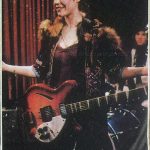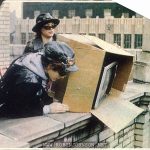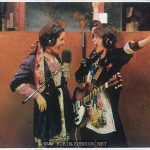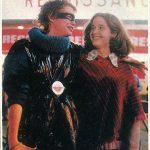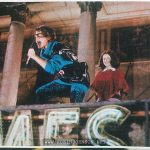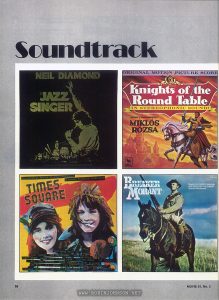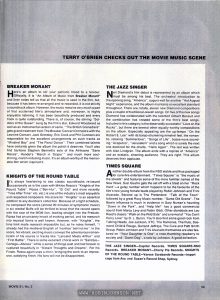“There’s a hot new talent, Robin Johnson in Robert Stigwood’s Times Square…”
Times Square was still in theaters in London when the February Movie 81 came out in Australia and editor John Fraser made the above announcement.
The two-page spread later in the issue is comprised of “An Appraisal by Terry O’Brien,” which from here in the 21st Century reads more like a promotional press release than a critical review. It is, though, an early adopter of the tone of most of the remaining publicity for Times Square, shifting its focus as hard as it can from the movie overall to Robin herself. “She is a find of the first order!”
The neon nerve centre of young New York, tuned to a furious rock beat—amps up, full power on, with all-night disc jockey Johnny (Tim Curry) perched in his skyscraper studio waiting for the moment.
TIMES SQUARE
AN APPRAISAL BY TERRY O BRIENLike the music which accompanies it on a pulsating soundtrack of rock, Times Square is a story of the streets. It’s about rebellion on a small scale, a search for some kind of basic freedom and a need to live life rather than simply exist. By setting the story in Times Square (surely the definitive microcosm of all that is good and bad in pre-packaged urban society), there’s a perfect, ready-made background of excitement, urgency and even danger that is inherent in that milieu. Surviving day to day in this environment is Nicky Marotta (Robin Johnson) a free spirit with aspirations of becoming a rock star. Her very wayward, uncompromising manner lands her in a psychiatric hospital for tests. While there, she meets Pamela Pearl (Trini Alvarado), a shy girl whose personality, unlike Nicky’s, has been submerged by her environment. She is, in fact, at quite the opposite end of the spectrum to Nicky. Moreover, Pamela’s father is a politician who has promised to clean up the seedier side of Times Square. The two girls escape from the hospital and, in their own way, take on the establishment with acts that supposedly symbolise their rejection of the plastic culture. Their exploits are covered and encouraged by Johnny LaGuardia (Tim Curry), a disc-jockey who turns the couple into celebrities with a following which allows Nicky, ultimately, a brief moment of fame as a rock singer. Another aspect of the story is the effect that each of the girls has on the other. Nicky’s life-style allows Pamela to experiment with her own and to break out of her protective shell. (It’s interesting that once she has had her freedom she decides to return to her father, though, one suspects, on her own terms.) Conversely, the poetic and sensitive Pamela brings about a change in Nicky who finds she has her first real friend and, subsequently, a basis for believing in herself. Robin Johnson, in her movie debut, is a sensation. Her Nicky is vibrant, exciting and fragile—and one of the most interesting movie characters in years. She is a find of the first order! Trini Alvarado is her perfect foil and willing pupil. Tim Curry’s eccentric exploitive disc-jockey is a far cry from his Frank N’ Furter in The Rocky Horror Picture Show, but is, again, a fascinating performance. The movie’s feeling of rebellion and non-acceptance of some of society’s values is reflected in the music—a constant background of rock by some of today’s more prominent performers. James A. Contner’s cameras have caught some spectacular shots of New York, especially from atop the building from which Johnny broadcasts. Times Square is a showcase for some new and little-seen talent.
Producers: Robert Stigwood
Jacob Brackman
Director: Allan Moyle
The real treasures here are the accompanying photographs. Within an assortment of publicity stills we’ve seen before are two more behind-the-scenes shots, one of Trini, Tim, and Robin on Pier 56 on the Hudson River, and one of Robin and Trini during the shooting of the concert in Times Square. The three-shot must come from the same break in shooting that produced the top photo on page 22 of Film Review, Vol. 31 No. 1, and the black and white photo in the UK Press Kit, and which I’ve noted before are among the very few photos from Times Square with the actors in costume smiling directly at the camera.
The shot of Robin and Trini probably was taken within moments of the slide of Robin in Aggie Doon makeup on 42nd Street; Nicky is only on that street in the makeup after she jumps from the marquee, and Pammy is never down there with her. This photo was taken either before, during a break in, or after filming.
The other photos are UK lobby cards (or suspected lobby cards), except the Yoram Kahana photograph from the session that also produced the shot that became half of the movie poster and soundtrack album cover, and the slide of Aggie Doon debuting Damn Dog, which I think is seeing its first publication here.
And that’s not all! On page 47, we find an ad featuring for the first time the English South Pacific movie poster. The collaged artwork featuring a Mick Rock photo previously appeared in a production promotional ad in Screen International in June of 1980. Here we see the debut of the new tag line, “… is the music of the streets!” which still doesn’t exactly make sense, but is a step up from England’s “Go sleaze!”
But wait, there’s more! As a bonus, on pages 59, our friend Terry O’Brien gives the soundtrack a glowing review.
Soundtrack
TERRY O’BRIEN CHECKS OUT THE MOVIE MUSIC SCENE
TIMES SQUARE
Another double-album from the RSO stable and thus packaged for sure-fire entertainment. “Times Square” is “the music of the streets” and features some of the more familiar names of the New Wave. Suzi Quatro gets the set off with a blast on her “Rock Hard”—a gutsy number which happens to be the favourite of the film’s two young female leads played by Robin Johnson and Trini Alvarado. Second up is The Pretenders’ “Talk of the Town” followed by a great Roxy Music number, “Same Old Scene”. The Bowie influence is much in evidence in Gary Numan’s haunting “Down in the Park”, and “Help Me!” has a good commercial sound from Marcy Levy and Robin Gibb. Other standouts are Lou Reed’s classic “Walk on the Wild Side” and a revival of “You Can’t Hurry Love” by D. L. Byron. You’ll also find some good rock from Talking Heads, Joe Jackson, XTC, The Ramones, The Ruts, Desmond Child & Rouge, Garland Jeffreys, The Cure and Patti Smith Group. Robin Johnson and Trini Alvarado themselves are also featured on “Your Daughter is One” a nose-thumbing raspberry to society and “Damn Dog”, a solo by Johnson. A good collection.
TIMES SQUARE-RSO Records
Movie 81, No. 2, February 1981 (magazine (periodical), AAT ID: 300215389) ; 27.2 x 20 cm.; (contains:)
John Fraser, Editorial (editorial, AAT ID: 300026284), p. 3
Times Square : an appraisal by Terry O’Brien (review (document), AAT ID: 300026480), pp. 14-15
[Times Square is the music of the streets], (advertisement, AAT ID: 300193993), p. 47
Soundtrack : Terry O’Brien checks out the movie music scene : Times Square (review (document), AAT ID: 300026480), pp. 58-59 (work)
1981-02 Movie 81 No 2 cover_1080px.jpg
1080 x 794 px, 96 dpi, 535 kb
1981-02 Movie 81 No 2 p03_1080px.jpg
1080 x 794 px, 96 dpi, 383 kb
1981-02 Movie 81 No 2 p03_detail_800px.jpg
800 x 789 px, 96 dpi, 315 kb
1981-02 Movie 81 No 2 p14-15_edit_1080px.jpg
1080 x 1580 px, 96 dpi, 1.04 mb
1981-02 Movie 81 No 2 p14-15_image_1_800px.jpg
484 x 800 px, 96 dpi, 242 kb
1981-02 Movie 81 No 2 p14-15_image_2_800px.jpg
800 x 551 px, 96 dpi, 325 kb
1981-02 Movie 81 No 2 p14-15_image_3_800px.jpg
522 x 800 px, 96 dpi, 334 kb
1981-02 Movie 81 No 2 p15_image_4_800px.jpg
533 x 800 px, 96 dpi, 376 kb
1981-02 Movie 81 No 2 p15_image_5_fixed_800px.jpg
800 x 533 px, 96 dpi, 291 kb
1981-02 Movie 81 No 2 p15_image_6_800px.jpg
800 x 532 px, 96 dpi, 352 kb
1981-02 Movie 81 No 2 p15_image_7_800px.jpg
549 x 800 px, 96 dpi, 380 kb
1981-02 Movie 81 No 2 p15_image_8_800px.jpg
556 x 800 px, 96 dpi, 305 kb
1981-02 Movie 81 No 2 p47_1080px.jpg
1080 x 780 px, 96 dpi, 467 kb
1981-02 Movie 81 No 2 p58_1080px.jpg
1080 x 788 px, 96 dpi, 532 kb
1981-02 Movie 81 No 2 p59_1080px.jpg
1080 x 791 px, 96 dpi, 540 kb (images)





